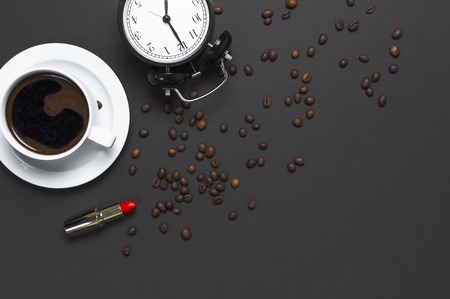1. Introduction to Coffee Storage in British Kitchens
In recent years, the UK has witnessed a dynamic transformation in its coffee culture. From the bustling high streets of London to cosy village cafés, Britons have developed a keen appreciation for quality brews, with an increasing number opting to prepare speciality coffees at home. As a result, storing coffee correctly has become essential for preserving flavour and freshness. Unlike continental kitchens, British kitchens are often compact, blending tradition with modernity and typically featuring limited cupboard or counter space. This unique setting demands storage solutions that not only protect coffee from moisture, light, and air but also fit seamlessly into the distinctive layouts of UK homes. Understanding the importance of proper storage is key to ensuring every cup brewed at home delivers on both aroma and taste—making the choice of container more than just a matter of aesthetics, but one of practical necessity tailored to the British way of life.
2. Key Factors When Choosing a Coffee Storage Container
When selecting the optimal coffee storage container for a British kitchen, several critical factors must be carefully evaluated to ensure your beans maintain their freshness and flavour integrity. Below, we discuss the primary considerations that distinguish superior containers from less suitable options in UK households.
Airtightness
The unpredictable British weather—characterised by its frequent humidity and fluctuating temperatures—makes airtightness an essential attribute. Airtight containers prevent oxidation, which degrades coffee aroma and taste. Look for containers with silicone or rubber seals and robust locking mechanisms to ensure minimal air exposure, especially in open-plan kitchens where temperature variations are common.
Light Protection
Direct sunlight and even ambient indoor light can accelerate the staling process of roasted coffee. In most British homes, kitchen counters are often near windows or under bright lighting. Opting for opaque or tinted containers protects beans from harmful UV rays, preserving their natural oils and preventing photodegradation.
Material Suitability for the British Climate
| Material | Advantages | Disadvantages |
|---|---|---|
| Stainless Steel | Excellent durability; non-reactive; good at blocking light; stable in humid conditions | Can be prone to dents if dropped; heavier than alternatives |
| Ceramic | Stylish; effective at blocking light; maintains stable internal temperature | Brittle; may chip or break if knocked against hard surfaces |
| BPA-Free Plastic | Lightweight; affordable; often transparent for easy monitoring of contents | Poor light protection unless tinted; can absorb odours over time |
| Glass | Non-reactive; easy to clean; visually appealing on open shelves | Poor at blocking light unless frosted or coloured; fragile in busy kitchen environments |
Practical Usability in Everyday Kitchen Environments
The realities of British kitchen layouts—often compact with limited counter space—demand practical solutions. Containers should fit easily into cupboards or on shelves, offer one-handed operation for convenience during morning routines, and provide clear labelling options for rotation of different bean types. Additional features like built-in date trackers or CO2 valves (for freshly roasted beans) cater to enthusiasts seeking optimal freshness.

3. Common Types of Coffee Storage Containers
When selecting a coffee storage container for a British kitchen, its essential to consider both practicality and how the container complements your home environment. Here’s a breakdown of the most common materials—glass, ceramic, metal, and plastic—each with distinct advantages and drawbacks, particularly relevant to UK households.
Glass Containers
Pros: Glass jars are visually appealing, making it easy to see your coffee beans or grounds at a glance—a handy feature for busy mornings in bustling British homes. Theyre non-reactive and do not impart flavours, maintaining the coffees freshness and aroma.
Cons: However, glass is prone to breakage and can let in light, which may degrade coffee quality over time. In kitchens with ample sunlight or limited cupboard space, this could be a notable drawback unless the glass is tinted or kept out of direct light.
Ceramic Containers
Pros: Ceramic containers are excellent for blocking out light and protecting beans from temperature fluctuations common in draughty Victorian or Edwardian homes. They often come in stylish designs that suit classic or contemporary British interiors.
Cons: These containers can be heavy and may chip if handled carelessly. While they offer superior protection against external elements, their weight might not suit those who prefer something more portable or easy to handle.
Metal Containers
Pros: Metal tins, particularly stainless steel varieties, offer robust protection against air and light. They’re durable and ideal for kitchens where space is at a premium or where containers are regularly moved about.
Cons: Some metals can impart off-flavours if not properly coated on the inside. Additionally, metal containers may develop dents over time, especially if stored among other heavy kitchenware—a consideration for compact British kitchens.
Plastic Containers
Pros: Plastic containers are lightweight and generally more affordable than other options. They come in various shapes and sizes, making them convenient for smaller British flats or shared accommodations.
Cons: Over time, plastic can absorb odours and stains, potentially affecting the flavour of your coffee. Also, lower-quality plastics may not offer an airtight seal, compromising freshness—an issue in homes where humidity fluctuates due to central heating systems.
Summary for British Kitchens
Selecting the right container depends largely on your specific kitchen environment and personal preferences. Consider factors such as available storage space, exposure to light, frequency of use, and aesthetic fit within your home. Each material offers unique benefits suited to different lifestyles typical across the UK—from urban flats to rural cottages—ensuring you can keep your coffee as fresh as possible while complementing your kitchen style.
4. Performance Analysis: Preserving Freshness and Flavour
When evaluating coffee storage containers for British kitchens, it is essential to consider how well each option preserves bean freshness, aroma retention, and overall cup quality, especially given the UKs temperate climate and the prevalence of central heating. Below is a technical analysis comparing the performance of various container types under typical UK household conditions.
Factors Affecting Coffee Freshness in UK Homes
The primary enemies of coffee freshness are oxygen, moisture, light, and temperature fluctuations. In British kitchens, humidity from boiling kettles and varying temperatures due to central heating can accelerate staling. Thus, the choice of storage solution must address these specific challenges.
Container Types and Their Technical Performance
| Container Type | Oxygen Barrier | Light Protection | Moisture Resistance | Aroma Retention | Cup Quality Over Time |
|---|---|---|---|---|---|
| Glass Jar (with Seal) | Moderate (if airtight) | Poor | Good | Moderate | Declines after 7-10 days |
| Plastic Container (Food Grade) | Variable | Poor–Moderate (opaque types better) | Good | Moderate–Poor (risk of aroma absorption) | Noticeable decline after 5-7 days |
| Stainless Steel Canister (Airtight) | Excellent | Excellent | Excellent | Excellent | Keeps beans fresher up to 2 weeks+ |
| Ceramic Jar (with Seal) | Good | Excellent | Good | Good | Slight loss after 7-10 days |
| Vacuum-Sealed Container | Outstanding | Excellent (if opaque) | Outstanding | Outstanding | Keeps beans near peak up to 3 weeks+ |
| Coffee Bag with One-Way Valve | Good initially, declines as opened/closed repeatedly | Poor–Moderate (unless stored in a cupboard) | Poor once open | Good initially, declines over time | Loses vibrancy after 5-7 days once opened |
Tasting Outcomes and Cup Quality Impacted by Storage Choice
The technical differences between containers become apparent during cupping sessions. Stainless steel and vacuum-sealed options consistently deliver brighter acidity, pronounced origin characteristics, and preserved sweetness even after two weeks—a key consideration for those who grind fresh daily at home. By contrast, glass and plastic containers tend to result in muted aromatics and flat flavour notes within a week due to greater exposure to light or minor air ingress.
Best Practices for UK Households
- Avoid storing coffee on worktops near kettles or ovens where heat and steam are present.
- Select opaque or metal canisters to minimise light exposure.
- If using bags with valves, decant into airtight containers as soon as possible after opening.
Summary Table: Recommended Container Performance for British Conditions
- Avoid storing coffee on worktops near kettles or ovens where heat and steam are present.
- Select opaque or metal canisters to minimise light exposure.
- If using bags with valves, decant into airtight containers as soon as possible after opening.
Summary Table: Recommended Container Performance for British Conditions
| Container Type | Recommended Use Period After Opening (Days) |
|---|---|
| Vacuum-Sealed/Opaque Metal Canister | >14–21+ |
| Ceramic/Glass with Silicone Seal | 7–10 |
| Coffee Bag/Standard Plastic | <7 |
The right storage container significantly extends the window of peak freshness for specialty beans enjoyed in the home setting. For discerning UK coffee drinkers seeking consistent quality and vibrant cup character, investing in a high-performance solution tailored to local kitchen environments is highly recommended.
5. Aesthetic and Practical Considerations for British Kitchens
When selecting the ideal coffee storage container for a British kitchen, both aesthetic appeal and practical functionality must be taken into account. The style of British kitchens ranges from classic Victorian or Georgian-inspired spaces with their ornate cabinetry and muted palettes to sleek, modern designs marked by minimalist lines and integrated appliances. Coffee storage solutions should harmonise with these diverse aesthetics, whether they are traditional ceramic jars featuring vintage motifs or contemporary stainless steel canisters with clean, understated finishes.
Space constraints are another vital factor. British homes often feature compact kitchens, particularly in urban settings. As such, the size and shape of a coffee container become crucial. Stackable or modular containers offer efficient use of limited cupboard or countertop space, while slimline options can fit neatly into narrow cupboards without sacrificing capacity. Some households may favour wall-mounted dispensers or magnetic containers to further maximise available space.
In terms of everyday practicality, ease of access is essential for the British ritual of making a morning brew or entertaining guests at tea time. Airtight seals and one-handed opening mechanisms streamline the process, allowing quick retrieval without compromising freshness. Materials matter as well; glass containers allow users to monitor bean levels at a glance, while opaque tins protect against light exposure – both popular choices depending on user preference and kitchen lighting conditions.
Ultimately, the best coffee storage container will complement the unique character of each British kitchen while meeting the demands of daily life. By balancing visual harmony with space-saving designs and functional features, homeowners can ensure their coffee remains fresh and their kitchen remains both beautiful and organised.
6. Popular Brands and Where to Buy in the UK
When selecting a coffee storage container for your British kitchen, the marketplace offers an impressive variety of reputable brands catering to both traditional preferences and modern sensibilities. Among the most prominent names, Airtight Solutions, OXO Good Grips, and Le Creuset stand out for their commitment to quality and durability. Local favourite Robert Welch is renowned for marrying stainless steel craftsmanship with sleek design, while British-born Mason Cash continues to impress with its heritage-inspired ceramic canisters.
Brick-and-Mortar Shops
If you prefer shopping in person, established retailers such as John Lewis & Partners, Lakeland, and Dunelm offer wide selections of coffee containers tailored to diverse needs. These shops frequently stock leading international brands alongside homegrown British options, allowing you to compare finishes, test seals, and ensure compatibility with your kitchen aesthetic.
Online Retailers
For those seeking convenience or a broader range of choices, online platforms like Amazon UK, Wayfair UK, and the dedicated websites of specific brands provide extensive catalogues. Many independent British businesses also sell directly through platforms such as Not On The High Street and Etsy UK, where handmade or bespoke containers—often crafted from sustainable materials—are readily available.
Sustainability and Supporting Local Businesses
The growing awareness around sustainability has led many shoppers to prioritise eco-friendly options. Brands such as A Slice of Green and Bambaw focus on plastic-free, reusable solutions using responsibly sourced bamboo, glass, or stainless steel. By purchasing from British-based producers or small-scale artisans, you not only reduce your carbon footprint but also contribute to the vibrancy of local economies.
Making an Informed Choice
The UK market excels at offering a balance between high-quality imports and innovative local creations. Whether you favour classic stoneware jars from a heritage brand or are drawn to contemporary vacuum-sealed canisters with CO2-release valves, British shops—both physical and online—provide ample opportunity to find a container that preserves your beans’ freshness while aligning with your values.
7. Recommendations and Final Thoughts
When it comes to preserving the nuanced flavours and aromas of coffee, British coffee enthusiasts are spoiled for choice with a variety of storage containers tailored to different preferences and budgets. For those seeking premium quality and uncompromising freshness, airtight vacuum canisters such as stainless steel models with integrated CO₂ valves stand out as top-tier options. These are particularly well-suited for home baristas who invest in speciality beans and demand consistency in their brews.
For everyday drinkers or families looking for practical solutions without breaking the bank, glass or BPA-free plastic containers with robust seals offer excellent value while keeping coffee reasonably fresh. Stackable designs are especially advantageous for smaller British kitchens where space efficiency is a priority.
On-the-go professionals or those with limited counter space may appreciate compact, portable tins or resealable pouches that combine functionality with ease of use. In all cases, it’s essential to store containers in cool, dry places away from direct sunlight—regardless of material choice—to maximise bean longevity.
Ultimately, investing in a high-quality storage solution is about more than just prolonging shelf life; it’s about respecting the craft of roasting and the ritual of brewing. By choosing containers that suit your lifestyle and kitchen layout, you ensure every cup delivers the vibrant character British coffee lovers appreciate. Remember, even the finest beans can falter if improperly stored—so let effective storage be the unsung hero in your daily coffee routine.


